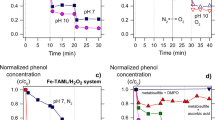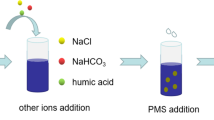Abstract
Degradation of methyl mercury (MeHg) and ethyl Hg (EtHg) with reactive oxygens was studied in vitro by using peroxidase-hydrogen peroxide (H2O2)-halide and rose bengal-ultraviolet light A systems. For this purpose, the direct determination method for inorganic Hg was employed. Both systems could effectively degrade EtHg, and MeHg to some extent. Degradation of MeHg and EtHg with the myeloperoxidase (MPO)-H2O2-chloride system was inhibited by MPO inhibitors (cyanide and azide), catalase, hypochlorous acid (HOCl) scavengers (glycine, alanine, serine and taurine), 1,4-diazabicyclo[2,2,2]octane and 2,5-dimethylfuran, but not by hydroxyl radical scavengers (ethanol and mannitol). Iodide was more effective than chloride as the halide component. Lactoperoxidase (LPO) could substitute for MPO in the iodide, but not the chloride system. With MPO-H2O2-chloride, MPO-H2 O2-iodide and LPO-H2O2-iodide systems, we observed the increased degradation of EtHg in deuterium oxide (D2O) medium better than that in H2O medium. The D2O effect upon MeHg degradation was extremely weak. These results suggested that HOCl (or HOI) might be also capable of degrading MeHg and EtHg, besides the hydroxyl radical already reported by us. Singlet oxygen could degrade EtHg but not MeHg.
Similar content being viewed by others
Abbreviations
- Hg:
-
mercury
- MeHg:
-
methyl mercury
- EtHg:
-
ethyl mercury
- O2 − :
-
superoxide anion
- H2O2 :
-
hydrogen peroxide
- OH:
-
hydroxyl radical
- 1O2 :
-
singlet oxygen
- HOCl:
-
hypochlorous acid
- HOI:
-
hypoiodous acid
- MPO:
-
myeloperoxidase
- LPO:
-
lactoperoxidase
- NAC:
-
N-acetyl-l-cysteine
- DETAPAC:
-
diethylenetriamine pentaacetic acid
- DABCO:
-
1,4-diazabicyclo[2,2,2]octane
- DMF:
-
2,5-dimethylfuran
- D2O:
-
deuterium oxide
- UV:
-
ultraviolet light
References
Chance B, Maehly AC (1955) Assay of catalases and peroxidases. In: Methods in enzymology, vol 2. Academic Press Inc., New York. pp 764–775
Dallegri F, Ballestrero A, Frumento G, Patrone F (1985) Erythrocyte lysis by PMA-triggered neutrophil polymorphonuclears: evidence for an hypochlorous acid-dependent process. Immunology 55: 639–645
Fang SC (1974) Induction of C-Hg cleavage enzymes in rat liver by dietary selenite. Res Commun Chem Pathol Pharmacol 9: 579–582
Fang SC, Fallin E (1974) Uptake and subcellular cleavage of organomercury compounds by rat liver and kidney. Chem Biol Interact 9: 57–64
Freeman BA, Crapo JD (1982) Biology of disease: free radicals and tissue injury. Lab Invest 47: 412–426
Halliwell B, Gutteridge JMC (1981) Formation of a thiobarbituric-acid-reactive substance from deoxyribose in the presence of iron salts: the role of superoxide and hydroxyl radicals. FEBS Lett 128: 347–352
Harrison JE, Watson BD, Schultz J (1978) Myeloperoxidase and singlet oxygen: a reappraisal. FEBS Lett 92: 327–332
Held AM, Hurst JK (1978) Ambiguity associated with use of singlet oxygen trapping agents in myeloperoxidase-catalyzed oxidations. Biochem Biophys Res Commun 81: 878–885
Ishihara N, Suzuki T (1976) Biotransformation of methylmercury in vitro. Tohoku J Exp Med 120: 361–363
Klebanoff SJ (1975) Antimicrobial mechanisms in neutrophilic polymorphonuclear leukocytes. Semin Hematol 12: 117–142
Klebanoff SJ (1980) Oxygen metabolism and the toxic properties of phagocytes. Ann Int Med 93: 480–489
Konishi T, Takahashi H (1983) Direct determination of inorganic mercury in biological materials after alkali digestion and amalgamation. Analyst 108: 827–834
Merkel PB, Kearns DR (1972) Radiationless decay of singlet molecular oxygen in solution: an experimental and theoretical study of electronic-to-vibrational energy transfer. J Am Chem Soc 94: 7244–7253
Midden WR, Wang SY (1983) Singlet oxygen generation for solution kinetics: clean and simple. J Am Chem Soc 105: 4129–4135
Nakayama M (1976) Biotransformation of methylmercury with special reference to hepatic microsomal cytochrome P-450-linked monooxygenase system. Kumamoto Med J 29: 95–109
Norseth T, Clarkson TW (1970) Studies on the biotransformation of203Hg-labeled methyl mercury chloride in rats. Arch Environ Health 21: 717–727
Parker CW (1984) Mediators: release and function. In: Paul WE (ed) Fundamental immunology. Raven Press, New York, pp 697–747
Pick E, Keisari Y (1980) A simple colorimetric method for the measurement of hydrogen peroxide produced by cells in culture. J Immunol Methods 38: 161–170
Rowland IR, Davies MJ, Evans JG (1980) Tissue content of mercury in rats given methylmercuric chloride orally: influence of intestinal flora. Arch Environ Health 35: 155–160
Slivka A, LoBuglio AF, Weiss SJ (1980) A potential role for hypochlorous acid in granulocyte-mediated tumor cell cytotoxicity. Blood 55: 347–350
Suda I, Totoki S, Takahashi H (1991) Degradation of methyl and ethyl mercury into inorganic mercury by oxygen free radical-producing systems: involvement of hydroxyl radical. Arch Toxicol 65: 129–134
Tezuka T, Tonomura K. (1976) Purification and properties of an enzyme catalyzing the splitting of carbon-mercury linkages from mercury-resistantPseudomonas K-62 strain: I. splitting enzyme 1. J Biochem 80: 79–87
Totoki S, Suda I, Takahashi H (1987) In vitro studies of the biotransformation of methyl mercury. In: Brown SS, Kodama Y (eds) Toxicology of metals: clinical and experimental research. Ellis Horwood Limited, West Sussex, pp 337–338
Weiss SJ, Klein R, Slivka A, Wei M (1982) Chlorination of taurine by human neutrophils: evidence for hypochlorous acid generation. J Clin Invest 70: 598–607
Author information
Authors and Affiliations
Rights and permissions
About this article
Cite this article
Suda, I., Takahashi, H. Degradation of methyl and ethyl mercury into inorganic mercury by other reactive oxygen species besides hydroxyl radical. Arch Toxicol 66, 34–39 (1992). https://doi.org/10.1007/BF02307267
Received:
Revised:
Accepted:
Issue Date:
DOI: https://doi.org/10.1007/BF02307267




